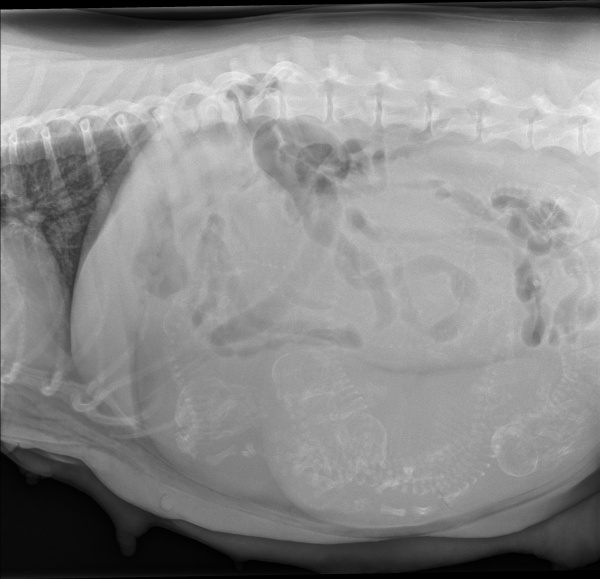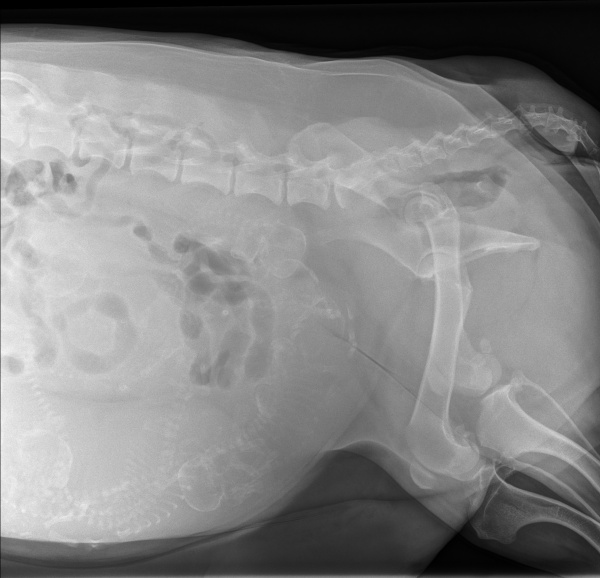Canine Dystocia
Written by Kelsie Norberg • 2025 Scholar
History
Lizzy is a 3 year old female basset hound presented to IVS as a triage for possible dystocia. Lizzy went into labor and had two puppies. The owner brought her in after an hour had passed since the last puppy was born. Previous X-rays had confirmed at least five puppies present.
Physical Exam Findings & Diagnostics
Upon physical exam, Lizzy was found to be tachycardic with developed mammary glands and milk expression, but no puppies appreciable in the vagina. Two fetal heart rates were found on ultrasound at rates of 220 and 240 bpm. After discussion with the veterinarian, the owner elected to take Lizzy home for another 1-1.5 hours to see if she would give birth at home before attempting hospital management.
Lizzy re-presented after the unsuccessful attempt to birth at home. Ultrasound examination showed signs of fetal distress. Fetal heart rates decreased to 130-150 bpm. Radiographs showed 8-10 puppies still present in the uterus indicating a much higher risk for Lizzy and the puppies.


Diagnosis
Lizzy was diagnosed with dystocia and determined to have a guarded prognosis by Dr. Bartlett.
Dystocia in Canines
Dystocia is the inability to complete eutocia, or giving birth. In a healthy canine pregnancy, gestation lasts 62-64 days from ovulation. Canine fetuses have low survivability if labor begins 48-72 hours early. This is why it is important to determine fetal maturity to determine if dystocia is occurring or an abortion. Abortions are poorly documented in canines.
In dogs, dystocia is most often due to uterine inertia. Either the uterus does not respond to fetal signals or the myometrium is exhausted due to obstruction. Dystocia can also be caused by abnormal vaginal conformation, metabolic issues, transverse fetal position, or fetal abnormalities. Some dogs are predisposed to dystocia, such as brachycephalic dogs, achondroplastic dogs, or dogs with large litters.
On physical examination, it is important to confirm fetal presence. Puppies can be observed in the vaginal canal or found on ultrasonography or radiographs. Time between delivery of puppies is concerning at 2 hours. Calcium and oxytocin therapy can be used to help increase contraction number and strength. This method will not work in the case of an obstruction.
The fetus is considered in distress when fetal heart rate is below 180 bpm. At this point, C-section is the best treatment for fetal survival. Puppies born from a dystocia patient may experience hypoxia and may require more medical attention and monitoring.
Treatment
Lizzy was transferred to ISU for emergency c-section. She successfully had 8 more healthy puppies.
Sources
- A. Hesser. Canine Dystocia Management. World Small Animal Veterinary Association Congress Proceedings, 2019. Reproductive Services, Animal Emergency Center of Tulsa, Tulsa, OK, USA. https://www.vin.com/members/cms/project/defaultadv1.aspx?pid=24437&catId=&id=9382877&said=&meta=&authorid=&preview=
- Philip Thomas, BVSc, PhD, FACVSc, DACT. Pregnancy and Dystocia. World Small Animal Veterinary Association World Congress Proceedings, 2013. Queensland Veterinary Specialists, Stafford Heights, Queensland, Australia.
https://www.vin.com/members/cms/project/defaultadv1.aspx?pid=11372&catId=&id=5709847&said=&meta=&authorid=&preview= - Clare M. Scully, DVM, DACT, Department of Veterinary Clinical Sciences, School of Veterinary Medicine. Dystocia in Small Animals. MSD Veterinary Manual. https://www.vin.com/doc/?id=11436190&pid=27848


